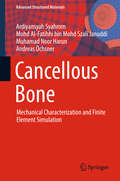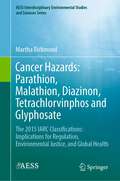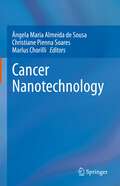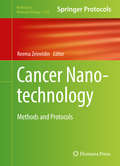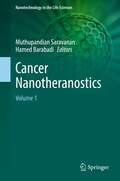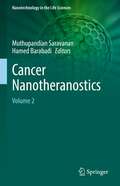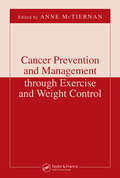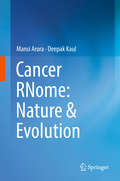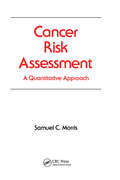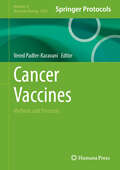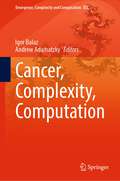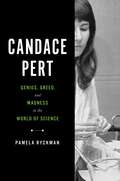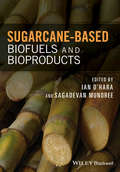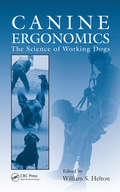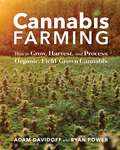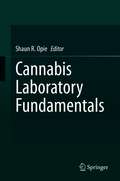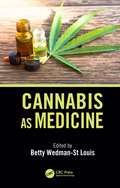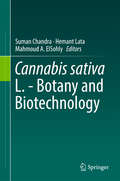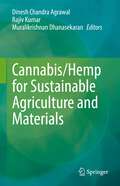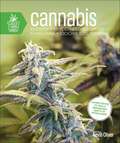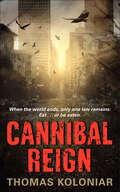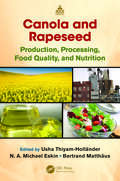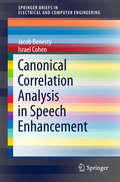- Table View
- List View
Cancellous Bone: Mechanical Characterization and Finite Element Simulation (Advanced Structured Materials #82)
by Andreas Öchsner Muhamad Noor Harun Ardiyansyah Syahrom Mohd Al-Fatihhi bin Mohd Szali JanuddiThis book provides comprehensive mechanobiological insights into bone, including the microstructure of cancellous bone and its realistic loading in the human body. This approach considers different types of loads, i. e. static and dynamic, and the response under uniaxial and multiaxial loading conditions. The book also reviews additional factors influencing biomechanical properties, e. g. fluid transport. In closing, the mechanobiological approach is discussed in the context of the finite element method.
Cancer Biomarkers: Minimal and Noninvasive Early Diagnosis and Prognosis
by Mukesh Verma Debmalya Barh Mehmet Gunduz Angelo CarpiGleaning information from more than 100 experts in the field of cancer diagnosis, prognosis, and therapy worldwide, Cancer Biomarkers: Non-Invasive Early Diagnosis and Prognosis determines the significance of clinical validation approaches for several markers. This book examines the use of noninvasive or minimally invasive molecular cancer m
Cancer Hazards: The 2015 IARC Classifications: Implications for Regulation, Environmental Justice, and Global Health (AESS Interdisciplinary Environmental Studies and Sciences Series)
by Martha RichmondThis book focuses on a monograph published in 2017 by the International Agency for Research on Cancer (IARC), an agency of the World Health Organization (WHO), discussing its carcinogen hazard classification of four pesticides: parathion, malathion, diazinon, and tetrachlorvinphos as well as the herbicide glyphosate. The monograph provided a detailed discussion of considerations and conclusions made by a group of experts who met in 2015 to evaluate these compounds. Although not universally true, many of these substances, from the time of their commercial introduction to their present-day use, have spread significantly in the environment, affecting animals and plants in the larger ecosystem, the overall health of the environment, and human health. This book develops each of these issues before turning to the IARC review process, both the general process and its evolution over time, and compound selection criteria and deliberations regarding the substances discussed in the 2017 monograph. Final book sections detail scientific and private sector reactions to and implications of the IARC classifications. Hazard identification is contrasted with various models of quantitative risk assessment. The last chapters highlight the importance of hazard identification for members of domestic and global underserved communities involved in farming and landscape work, where exposures may vary widely, are not well-regulated, and where health outcomes are often not carefully documented.
Cancer Nanotechnology
by Ângela Maria Almeida de Sousa Christiane Pienna Soares Marlus ChorilliCancer nanotechnology is a growing, emerging area of cross-disciplinary research that aims to develop efficient, specific and noninvasive approaches to restore the health and well-being of all cancer patients through more effective diagnosis and treatment. This new volume serves as a fundamental guide to cutting-edge topics in cancer nanotechnology, including advances in therapy, the use of nanoparticles and nanomaterials, future directions for nanocarriers in cancer therapy, and the application of DNA and RNA nanovaccines. Organized into four sections, the volume presents an overview of research and innovation in the emerging field of nanotechnology as a powerful tool in the diagnosis, imaging and treatment of cancer. International experts author chapters addressing targets of cancer therapy, materials for cancer nanotechnology, strategies for cancer therapy using nanotechnology, and innovative nanotechnologies for cancer diagnosis and treatment. The volume will be useful for a broad audience, including cross-disciplinary researchers, trainees, health professionals, and experts in industry.
Cancer Nanotechnology: Methods and Protocols (Methods in Molecular Biology #1530)
by Reema ZeineldinThis detailed volume presents protocols for advancing the utility of nanotechnology in cancer research toward improving our understanding of cancer biology, prevention, diagnosis, and therapy. There are continuous new discoveries in the field of nanotechnology, thus creating new imaging systems or therapies, and this book focuses on how to employ certain discoveries for studying cancer by presenting principles along with techniques to allow for the transformation of any new discoveries in the field into cancer-studying tools with the hope of bringing in the involvement of biomedical scientists who can enhance the speed of discoveries toward cancer diagnosis and therapy. Written for the highly successful Methods in Molecular Biology series, chapters include introductions to their respective topics, lists of the necessary materials and reagents, step-by-step, readily reproducible laboratory protocols, and tips on troubleshooting and avoiding known pitfalls. Authoritative and motivating, Cancer Nanotechnology: Methods and Protocols serves as an ideal resource for biomedical scientists interested in the potential of this field as well as for physical scientists and engineers interested in employing nanotechnology in cancer diagnosis and therapy.
Cancer Nanotheranostics: Volume 1 (Nanotechnology in the Life Sciences)
by Muthupandian Saravanan Hamed BarabadiNanotechnology is an interdisciplinary research field that integrates chemistry, engineering, biology, and medicine. Nanomaterials offer tremendous opportunity as well as challenges for researchers. Of course, cancer is one of the world's most common health problems, responsible for many deaths. Exploring efficient anticancer drugs could revolutionize treatment options and help manage cancer mortality. Nanomedicine plays a significant role in developing alternative and more effective treatment strategies for cancer theranostics. This book mainly focuses on the emerging trends using nanomaterials and nanocomposites as alternative anticancer material’s. The book is divided into three main topic areas: how to overcome existing traditional approaches to combat cancer, applying multiple mechanisms to target the cancer cells, and how nanomaterials can be used as effective carriers. The contents highlight recent advances in interdisciplinary research on processing, morphology, structure, and properties of nanostructured materials and their applications to combat cancer.Cancer Nanotheranostics is comprehensive in that it discusses all aspects of cancer nanotechnology. Because of the vast amount of information, it was decided to split this material into two volumes. In the first volume of Cancer Nanotheranostics, we discuss the role of different nanomaterials for cancer therapy, including lipid-based nanomaterials, protein and peptide-based nanomaterials, polymer-based nanomaterials, metal-organic nanomaterials, porphyrin-based nanomaterials, metal-based nanomaterials, silica-based nanomaterials, exosome-based nanomaterials and nano-antibodies. In the second volume, we discuss the nano-based diagnosis of cancer, nano-oncology for clinical applications, nano-immunotherapy, nano-based photothermal cancer therapy, nano-erythrosomes for cancer drug delivery, regulatory perspectives of nanomaterials, limitations of cancer nanotheranostics, the safety of nano-biomaterials for cancer nanotheranostics, multifunctional nanomaterials for targeting cancer nanotheranostics, and the role of artificial intelligence in cancer nanotheranostics.
Cancer Nanotheranostics: Volume 2 (Nanotechnology in the Life Sciences)
by Muthupandian Saravanan Hamed BarabadiCancer Nanotheranostics, Volume 2 continues the discussion of the important work being done in this field of cancer nanotechnology. The contents of these two volumes are explained in detail as follows.In the first volume of Cancer Nanotheranostics, we discuss the role of different nanomaterials for cancer therapy including lipid-based nanomaterials, protein and peptide-based nanomaterials, polymer-based nanomaterials, metal-organic nanomaterials, porphyrin-based nanomaterials, metal-based nanomaterials, silica-based nanomaterials, exosome-based nanomaterials, and nano-antibodies.This important second volume discusses nano-based diagnosis of cancer, nano-oncology for clinical applications, nano-immunotherapy, nano-based photothermal cancer therapy, nanoerythrosomes for cancer drug delivery, regulatory perspectives of nanomaterials, limitations of cancer nanotheranostics, safety of nanobiomaterials for cancer nanotheranostics, multifunctional nanomaterials for targeting cancer nanotheranostics, and the role of artificial intelligence in cancer nanotheranostics.Volume 2 is a vital continuation of this two-volume set. Together, these two volumes create a comprehensive and unique examination of this important area of research.
Cancer Prevention and Management through Exercise and Weight Control
by Anne Mctiernan“..it is increasingly clear that cancer is also a disease of inertia. In this book, a broadly multidisciplinary group presents the evidence and provides the recommendations. … The antidote to diseases of inertia is movement — let’s move!” John Potter, M.D.,Ph.D., from the Foreword The American Cancer Society estimates that a third of all cancer deaths could be prevented through avoidance of obesity and the rejection of sedentary lifestyles. The World Health Organization also supports this claim. Additionally, these and other organizations now recognize the role that activity can play in improving the quality of life for cancer patients. Cancer Prevention and Management through Exercise and Weight Control provides us with the support necessary to make a call to action. It brings together the contributions of world-class researchers to lay out the evidence and a plan of attack for coping with this crisis. The text begins by focusing on the research methods used in assessing the complex associations between activity, energy balance, and risk and prognosis. In comprehensive literature reviews, the authors consider the role of physical activity in the incidence of individual cancers, then explore the mechanisms that might explain this connection. They continue with a look at the relation between weight and cancer incidence, including a consideration of genetics. Research is also provided linking physical activity and weight control to a cancer patient’s quality of life and prognosis. The work concludes with ideas on how a plan of action might be implemented at the individual, clinical, and public health levels. It also provides guidance on incorporating exercise and diet recommendations into clinical oncology practice.
Cancer RNome: Nature & Evolution
by Mansi Arora Deepak KaulIn the last decade, researchers working in the field of cancer biology have shifted their focus from genetic defects to epigenetic dysregulation, especially that of non-coding RNAs (ncRNAs). This book encompasses a comprehensive review of the transcriptional landscape of the cell and its involvement in the cancer pathophysiology. The first two chapters elucidate the basics of biosynthesis, mechanism of action and modulation of the epigenetic regulation of gene expression by coding as well as non-coding RNAs. The third chapter discusses the aberrant expression of the cellular RNome in the cancer cells and highlights its role in the orchestration of processes involved in evolution as well as the sustenance of cancer cells. The fourth chapter describes the recent advances in the field of translating the transcriptome into diagnostic/prognostic biomarkers and as targets for novel anti-cancer therapies. The final chapter then reviews the emerging experimental approaches to screen, identify and explore the functions of ncRNAs. Providing valuable insights into the field of RNome in the context of cancer, this book is helpful to students, researchers and clinicians..
Cancer Risk Assessment: A Quantitative Approach (Occupational Safety And Health Ser. #20)
by Samuel C. MorrisBased on the National Academy of Sciences approach to quantitative risk assessment. Emphasizes how an accurate assessment of cancer risk must draw on a wide range of disciplines, such as biology, chemistry, physics, engineering, and the social sciences. Provides tables of Poisson confidence limit fa
Cancer Vaccines: Methods and Protocols (Methods in Molecular Biology #2926)
by Vered Padler-KaravaniThis volume provides readers with an overview on the latest advances in cancer vaccines, and the major issues that need to be addressed in their development. The chapters in this book cover recent progress in immunotherapy; methods for generating relevant mouse models and engineering viral-based vaccines; oncolytic virus; glycosylation-based vaccines; and clinical production of dendritic cell cancer vaccines. Written in the highly successful Methods in Molecular Biology series format, chapters include introductions to their respective topics, lists of the necessary materials and reagents, step-by-step, readily reproducible laboratory protocols, and tips on troubleshooting and avoiding known pitfalls.Cutting-edge and thorough, Cancer Vaccines: Methods and Protocols is a valuable resource for expert and novice researchers and scientists who are looking to expand their knowledge or learn more about this important and developing field.
Cancer, Complexity, Computation (Emergence, Complexity and Computation #46)
by Andrew Adamatzky Igor BalazThis book presents unique compendium of groundbreaking ideas where scientists from many different backgrounds are united in their interest in interdisciplinary approaches towards origins and development of cancers, innovative ways of searching for cancer treatment and the role of cancer in the evolution. Chapters give an unequivocal slice of all areas that relate to a quest for understanding cancer and its origin as many-fold nonlinear system, complexity of the cancer developments, a search for cancer treatment using artificial intelligence and evolutionary optimisation, novel modelling techniques, molecular origin of cancer, the role of cancer in evolution of species, interpretation of cancer in terms of artificial life and artificial immune systems, swarm intelligence, cellular automata, computational systems biology, genetic networks, cellular computing, validation through in vitro/vivo tumour models and tumour on chip devices. The book is an inspiring blend of theoretical and experimental results, concepts and paradigms. Distinctive features The book advances widely popular topics of cancer origin, treatment and understanding of its progress The book is comprised of unique chapters written by world top experts in theoretical and applied oncology, complexity theory, mathematics, computer science. The book illustrates attractive examples of mathematical and computer models and experimental setups.
Candace Pert: Genius, Greed, and Madness in the World of Science
by Pamela RyckmanCandace Pert stood at the dawn of three revolutions: the opioid crisis, the AIDS crisis, and the mind-body movement. Indeed, her visionary work shaped history – for good and, inadvertently, for evil. Before there was Bessel van der Kolk, there was Candace Pert, the Mother of the Mind-Body Revolution. Her story forms a launchpad to discuss the most pressing issues plaguing science and healthcare today. Pert played pivotal roles in major movements in both science and politics. Namely, she: Discovered the opiate receptor (the mechanism by which opioids function in the brain), launching the opioid crisis. Proved the mind-body link, launching the field of integrative or functional medicine. Created Peptide T, the underground AIDS drug featured in the film Dallas Buyers Club, and then went rogue, becoming a linchpin in the black market for her drug. Pert was sabotaged by mentors and colleagues keen to profit from her brilliance. But she too became tainted, believing that her noble ends would justify devious means. Like a mythic hero, she succumbed to a fatal flaw, and her greatest strengths—singularity of purpose and blind faith in her own virtuosity—would prove to be her undoing. CANDACE PERT is a great read for anyone interested in integrative health, mind-body awareness, medical ethics, the bureaucracy of a toxic healthcare system, and a flawed genius whose scandals and breakthroughs shaped history. &“Exemplary research, balanced accounts and deeply evocative prose... a truly insightful narrative on what it can mean to be a woman at the cutting edge of science.&” – The Wall Street Journal &“Riveting biography… nuanced portrait…Readers will be engrossed.&” – Publisher's Weekly &“There is a revolution taking form that is significantly influencing how the Western medical community views health and disease. Candace Pert&’s contribution to this revolution is undeniable.&” – Deepak Chopra &“Ryckman&’s writing is life-like, suspenseful, and creates a roller coaster ride of stakes and unexpected discovery&” – Dr. Lisa Miller, New York Times bestselling author of The Spiritual Child and The Awakened Brain
Cane-based Biofuels And Bioproducts
by Sagadevan MundreeSugarcane has garnered much interest for its potential as a viable renewable energy crop. While the use of sugar juice for ethanol production has been in practice for years, a new focus on using the fibrous co-product known as bagasse for producing renewable fuels and bio-based chemicals is growing in interest. The success of these efforts, and the development of new varieties of energy canes, could greatly increase the use of sugarcane and sugarcane biomass for fuels while enhancing industry sustainability and competitiveness. Sugarcane-Based Biofuels and Bioproducts examines the development of a suite of established and developing biofuels and other renewable products derived from sugarcane and sugarcane-based co-products, such as bagasse. Chapters provide broad-ranging coverage of sugarcane biology, biotechnological advances, and breakthroughs in production and processing techniques. This text brings together essential information regarding the development and utilization of new fuels and bioproducts derived from sugarcane. Authored by experts in the field, Sugarcane-Based Biofuels and Bioproducts is an invaluable resource for researchers studying biofuels, sugarcane, and plant biotechnology as well as sugar and biofuels industry personnel.
Canine Ergonomics: The Science of Working Dogs
by William S. HeltonSince Canis lupus familiaris first shared a fire with man more than 15,000 years ago, dogs have been trusted and valued coworkers. Yet the relatively new field of canine ergonomics is just beginning to unravel the secrets of this collaboration. As with many new fields, the literature on working dogs is scattered across several non-overlapping disci
Cannabis Farming: How to Grow, Harvest, and Process Organic, Field-Grown Cannabis
by Adam Davidoff Ryan PowerStart your own organic cannabis farm with this complete how-to manual written by two farmers with a decade of experience growing cannabis in the field. Cannabis is rapidly being decriminalized across the country, causing a surge in consumer demand and enabling growers to cultivate cannabis in the open, rather than secretly in greenhouses. Whether you&’re a small-scale vegetable farmer who wants to add a high-value crop or a home cannabis grower who wants to expand their operation, authors Adam Davidoff and Ryan Power can help you get growing. They were some of the first vegetable farmers in California to start growing cannabis as a field crop, and have even developed their own cannabis strains that are adapted to field growing rather than indoor cultivation. Now is the perfect time to start growing cannabis for profit!
Cannabis Laboratory Fundamentals
by Shaun R. OpieThe legislative requirement for cannabis to undergo laboratory testing has followed legalization of medical and recreational use in every U.S. state to date. Cannabis safety testing is a new investment opportunity within the emerging cannabis market that is separate from cultivation, processing, and distribution, allowing individuals and organizations who may have been reluctant to enter previously a new entry route to the cannabis space. However, many of the costs, timelines, operational requirements, and compliance issues are overlooked by people who have not been exposed to regulated laboratory testing. Cannabis Laboratory Fundamentals provides an in-depth review of the key issues that impact cannabis testing laboratories and provides recommendations and solutions to avoid common – but expensive – mistakes. The text goes beyond methodology to include sections on economics, regulation, and operational challenges, making it useful for both new and experienced cannabis laboratory operators, as well as all those who want to understand the opportunities and risks of this industry.
Cannabis as Medicine
by Betty Wedman-St.LouisFor hundreds of years cannabis has been used as a therapeutic medicine around the world. Cannabis was an accepted medicine during the second half of the 19th century, but its use declined because single agent pain medications were advocated by physicians who demanded standardization of medicines. It was not until 1964 when the chemical structure of THC (delta 9-tetrahydrocannabinol) was elucidated and its pharmacological effects began to be understood. Numerous therapeutic effects of cannabis have been reviewed, but cannabis-based medicines are still an enigma because of legal issues. Many patients could benefit from cannabinoids, terpenoids and flavonoids found in Cannabis sativa L. These patients suffer from medical conditions including chronic pain, chronic inflammatory diseases, neurological disorders, and other debilitating illnesses. As more states are legalizing medical cannabis, prescribers need a reliable source which provides clinical information in a succinct format. This book focuses on the science of cannabis as an antioxidant and anti-inflammatory supplement. It discusses cannabis uses in the human body for bone health/osteoporosis; brain injury and trauma; cancer; diabetes; gastrointestinal conditions; mental health disorders; insomnia; pain; anxiety disorders; depression; migraines; eye disorders; and arthritis and inflammation. There is emphasis on using the whole plant — from root to raw leaves and flowers discussing strains, extraction and analysis, and use of cannabis-infused edibles. Features: Provides an understanding of the botanical and biochemistry behind cannabis as well as its use as a dietary supplement. Discusses endocannabinoid system and cannabinoid receptors. Includes information on antioxidant benefits, pain receptors using cannabinoids, and dosage guidelines. Presents research on cannabis treatment plans, drug-cannabis interactions and dosing issues, cannabis vapes, edibles, creams, and suppositories. Multiple appendices including a glossary of cannabis vocabulary, how to use cannabis products, a patient guide and recipes as well as information on cannabis for pets.
Cannabis sativa L. - Botany and Biotechnology
by Suman Chandra Hemant Lata Mahmoud A. ElsohlyThis book highlights current Cannabis research: its botany, authentication, biotechnology, in vitro propagation, chemistry, cannabinoids biosynthesis, metabolomics, genomics, biomass production, quality control, and pharmacology. Cannabis sativa L. (Family: Cannabaceae) is one of the oldest sources of fiber, food and medicine. This plant has been of interest to researchers, general public and media not only due to its medicinal properties but also the controversy surrounding its illicit use. Cannabis has a long history of medicinal use in the Middle East and Asia, being first introduced as a medicine in Western Europe in the early 19th century. Due to its numerous natural constituents, Cannabis is considered a chemically complex species. It contains a unique class of terpeno-phenolic compounds (cannabinoids or phytocannabinoids), which have been extensively studied since the discovery of the chemical structure of tetrahydrocannabinol (Δ9-THC), commonly known as THC, the main constituent responsible for the plant's psychoactive effects. An additionally important cannabinoid of current interest is Cannabidiol (CBD). There has been a significant interest in CBD and CBD oil (extract of CBD rich Cannabis) over the last few years because of its reported activity as an antiepileptic agent, particularly its potential use in the treatment of intractable epilepsy in children.
Cannabis/Hemp for Sustainable Agriculture and Materials
by Dinesh Chandra Agrawal Rajiv Kumar Muralikrishnan DhanasekaranThe book contains review articles on the latest evidence-based scientific knowledge and future insights on industrial hemp applications ranging from sustainable agriculture, sustainable development, and commercial uses of hemp-derived innovative products. The research articles evaluate and review the latest research and development on hemp’s agronomy, ecophysiology, the opportunities and challenges of hemp cultivation in the different regions of the world, including Africa.The book reviews complete patent literature on hemp from the publication of the first patent in 1856 till the end of 2020, providing an excellent insight into hemp’s business growth and future potential for industrial applications along with region- and sector-wise patenting activity concerning industrial hemp. In addition, articles describe the applications of hemp-derived green materials for building construction, wastewater treatment, and water purification. The book will be useful as a reference book for students, researchers, farmers, business houses, and individuals interested in industrial hemp for commercial aspects, sustainable development, farming, and other hemp-derived innovative products.
Cannabis: A Complete Guide
by Ernest SmallCannabis sativa is best known as the source of marijuana, the world’s most widely consumed illicit recreational drug. However, the plant is also extremely useful as a source of stem fiber, edible seed oil, and medicinal compounds, all of which are undergoing extremely promising research, technological applications, and business investment. Indeed, despite its capacity for harm as a recreational drug, cannabis has phenomenal potential for providing new products to benefit society and for generating extensive employment and huge profits. Misguided policies, until recently, have prevented legitimate research on the beneficial properties of cannabis, but there is now an explosion of societal, scientific, and political support to reappraise and remove some of the barriers to usage. Unfortunately, there is also a corresponding dearth of objective analysis. Towards redressing the limitation of information, Cannabis: A Complete Guide is a comprehensive reference summarizing botanical, business, chemical, ecological, genetic, historical, horticultural, legal, and medical considerations that are critical for the wise advancement and management of cannabis in its various forms. This book documents both the risks and benefits of what is indisputably one of the world’s most important species. The conflicting claims for medicinal virtues and toxicological vices are examined, based mainly on the most recent authoritative scientific reviews. The attempt is made consistently to reflect majority scientific opinion, although many aspects of cannabis are controversial. Aside from the relevance to specialists, the general public should find the presentation attractive because of the huge interest today in marijuana. Unfortunately, society has become so specialized and compartmentalized that most people have limited appreciation of the importance of science to their lives, except when a topic like marijuana becomes sensationalized. This review of cannabis can serve as a vehicle for public education in the realm of science and technology. Indeed, towards the goal of disseminating the important information in this book to a wide audience, the presentation is user-friendly, concise, and well-illustrated in the hope that non-specialists will find the topics both informative and entertaining.
Cannabis: Everything You Need to Grow Marijuana Indoors and Outdoors (Green Thumb Guides)
by Kevin OliverCultivate your personal cannabis crop with expert techniques and know-how.As marijuana laws in the United States become less restrictive, more people are searching for basic marijuana gardening instructions. Cultivating marijuana isn't like growing other plants, especially if you desire maximum potency and yield. The cannabis plant requires special care, from the soil, water, and nutrients used to the temperature, light, and ventilation levels. Cannabis covers it all in a simple, concise way to help you increase both the quality and yield of your personal harvest.Here&’s what you&’ll find in this updated visual guide:Instructions on how to grow and maintain a small marijuana garden for your own noncommercial useThe full spectrum of options available for growing marijuana, from indoor, climate-controlled systems to open-air and outdoor growingTime-tested techniques and modern methods for strain selection, disease and pest prevention, and proper plant nutritionExpert advice to yield a consistent and dependable supply of buds
Cannibal Reign
by Thomas KoloniarA new star bursts onto the post-apocalyptic fiction scene: Thomas Koloniar. An epic dark saga set in a dystopian near-future, Cannibal Reign follows the fortunes of a small band of survivors, as they make their way across a nightmare landscape populated by bestial, flesh-eating savages after an asteroid strike destroys America. A dark, smart, action-packed vision of a terrifying possible tomorrow—when the only law left is “eat or be eaten”—Koloniar’s Cannibal Reign is an absolute must-read for fans of TV’s zombie smash hit The Walking Dead, Cormac McCarthy’s The Road, Lucifer’s Hammer, the Mad Max movies, and, of course, Stephen King’s immortal horror masterwork The Stand.
Canola and Rapeseed: Production, Processing, Food Quality, and Nutrition
by Usha Thiyam-Holländer Bertrand Matthäus N. A. Michael EskinIn 2010, esteemed researchers gathered at a workshop held at the Richardson Centre for Functional Foods and Nutraceuticals at the University of Manitoba in Winnipeg, Canada. Drawn from these proceedings, Canola and Rapeseed: Production, Processing, Food Quality, and Nutrition presents state-of-the-art information on the chemistry of the minor const
Canonical Correlation Analysis in Speech Enhancement (SpringerBriefs in Electrical and Computer Engineering)
by Jacob Benesty Israel CohenThis book focuses on the application of canonical correlation analysis (CCA) to speech enhancement using the filtering approach. The authors explain how to derive different classes of time-domain and time-frequency-domain noise reduction filters, which are optimal from the CCA perspective for both single-channel and multichannel speech enhancement. Enhancement of noisy speech has been a challenging problem for many researchers over the past few decades and remains an active research area. Typically, speech enhancement algorithms operate in the short-time Fourier transform (STFT) domain, where the clean speech spectral coefficients are estimated using a multiplicative gain function. A filtering approach, which can be performed in the time domain or in the subband domain, obtains an estimate of the clean speech sample at every time instant or time-frequency bin by applying a filtering vector to the noisy speech vector. Compared to the multiplicative gain approach, the filtering approach more naturally takes into account the correlation of the speech signal in adjacent time frames. In this study, the authors pursue the filtering approach and show how to apply CCA to the speech enhancement problem. They also address the problem of adaptive beamforming from the CCA perspective, and show that the well-known Wiener and minimum variance distortionless response (MVDR) beamformers are particular cases of a general class of CCA-based adaptive beamformers.
